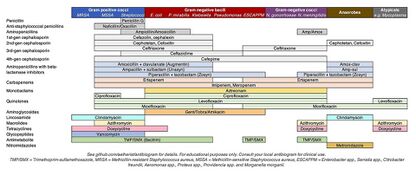Chemistry:Antimicrobial spectrum
The antimicrobial spectrum of an antibiotic means the range of microorganisms it can kill or inhibit. Antibiotics can be divided into broad-spectrum antibiotics, extended-spectrum antibiotics and narrow-spectrum antibiotics based on their spectrum of activity. Detailedly, broad-spectrum antibiotics can kill or inhibit a wide range of microorganisms; extended-spectrum antibiotic can kill or inhibit Gram positive bacteria and some Gram negative bacteria; narrow-spectrum antibiotic can only kill or inhibit limited species of bacteria.[1][2][3]
Currently no antibiotic's spectrum can completely cover all types of microorganisms.[4]
Determination
The antimicrobial spectrum of an antibiotic can be determined by testing its antimicrobial activity against a wide range of microbes in vitro . Nonetheless, the range of microorganisms which an antibiotic can kill or inhibit in vivo may not always be the same as the antimicrobial spectrum based on data collected in vitro.[2][5]
Significance
Narrow-spectrum antibiotics have low propensity to induce bacterial resistance and are less likely to disrupt the microbiome (normal microflora).[3] On the other hand, indiscriminate use of broad-spectrum antibiotics may not only induce the development of bacterial resistance and promote the emergency of multidrug-resistant organisms, but also cause off-target effects due to dysbiosis.[3][6] They may also have side effects, such as diarrhea or rash.[7] Generally, a broad antibiotic has more clinical indications, and therefore are more widely used.[2][8] The Healthcare Infection Control Practices Advisory Committee (HICPAC) recommends the use of narrow-spectrum antibiotics whenever possible.[9]
Examples
- Broad-spectrum antibiotic: Ciprofloxacin, Doxycycline, Minocycline, Tetracycline,[1] Imipenem, Azithromycin
- Extended-spectrum antibiotic: Ampicillin[1]
- Narrow-spectrum antibiotic: Sarecycline,[10] Vancomycin, Isoniazid[1]
See also
References
- ↑ 1.0 1.1 1.2 1.3 Michelle A. Clark (2009) (in en). Pharmacology (5th ed.). USA: Lippincott Williams & Wilkins. pp. 375–376. ISBN 978-1-4511-4320-1. https://archive.org/details/pharmacologythed00harv.
- ↑ 2.0 2.1 2.2 David Warrell; Timothy M. Cox; John Firth; Estée Török (11 October 2012). Oxford Textbook of Medicine: Infection. OUP Oxford. p. 39. ISBN 978-0-19-965213-6. https://books.google.com/books?id=hEjqD-ygu8AC&pg=PA39.
- ↑ 3.0 3.1 3.2 Melander, Roberta J.; Zurawski, Daniel V.; Melander, Christian (2018). "Narrow-Spectrum Antibacterial Agents". MedChemComm 9 (1): 12–21. doi:10.1039/C7MD00528H. ISSN 2040-2503. PMID 29527285.
- ↑ Erich Lück; Martin Jager (1997). Antimicrobial Food Additives: Characteristics, Uses, Effects. Springer Science & Business Media. p. 39. ISBN 978-3-540-61138-7. https://books.google.com/books?id=eydHuVtm-p8C&pg=PA39.
- ↑ Wiley W. Souba; Douglas W. Wilmore (23 February 2001). Surgical Research. Elsevier. p. 909. ISBN 978-0-08-054214-0. https://books.google.com/books?id=OyQnRD5LjnAC&pg=PA909.
- ↑ Francino, M. P. (2015). "Antibiotics and the Human Gut Microbiome: Dysbioses and Accumulation of Resistances". Frontiers in Microbiology 6: 1543. doi:10.3389/fmicb.2015.01543. ISSN 1664-302X. PMID 26793178.
- ↑ "Comparing Broad- and Narrow-Spectrum Antibiotics for Children with Ear, Sinus, and Throat Infections" (in en). 2014-10-08. https://www.pcori.org/research-results/2013/comparing-broad-and-narrow-spectrum-antibiotics-children-ear-sinus-and-throat.
- ↑ Andrew Hitchings; Dagan Lonsdale; Daniel Burrage; Emma Baker (30 March 2014). The Top 100 Drugs e-book: Clinical Pharmacology and Practical Prescribing. Elsevier Health Sciences. p. 94. ISBN 978-0-7020-5515-7. https://books.google.com/books?id=oeYjAwAAQBAJ&pg=PA94.
- ↑ "Antibiotic Stewardship Statement | HICPAC | CDC" (in en-us). 2019-04-15. https://www.cdc.gov/hicpac/recommendations/antibiotic-stewardship-statement.html.
- ↑ Zhanel, George; Critchley, Ian; Lin, Lynn-Yao; Alvandi, Nancy (January 2019). "Microbiological Profile of Sarecycline, a Novel Targeted Spectrum Tetracycline for the Treatment of Acne Vulgaris". Antimicrobial Agents and Chemotherapy 63 (1). doi:10.1128/AAC.01297-18. ISSN 1098-6596. PMID 30397052.
 |


